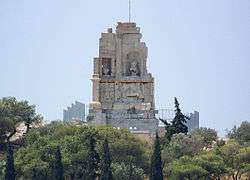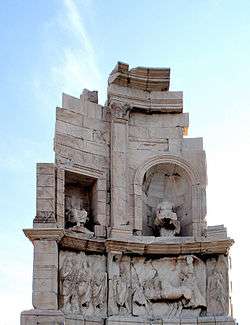Philopappos Monument


The Philopappu Monument (Greek: Μνημείο Φιλοπάππου) is an ancient Greek mausoleum and monument dedicated to Gaius Julius Antiochus Epiphanes Philopappos or Philopappus, (Greek: Γάιος Ιούλιος Αντίοχος Επιφανής Φιλόπαππος, 65–116 AD), a prince from the Kingdom of Commagene. It is located on Mouseion Hill in Athens, Greece, southwest of the Acropolis.
Origins
Philopappos died in 116, and his death caused great grief to his sister Julia Balbilla, citizens of Athens and possibly to the imperial family. As a dedication to honor the memory of Philopappos, Balbilla with the citizens of Athens erected a tomb structure on Muse Hill (Lofos Muson) near the Acropolis of Athens. His marble tomb monument is still known as the Philopappu Monument, and the hill is today known as Philopappu Hill (Λόφος Φιλοπάππου).
The Greek geographer Pausanias (Description of Greece, I.25.8), describes Philopappos’ grand tomb as a monument built for a Syrian man. The monument was built on the same site where Musaios or Musaeus, a 6th-century BC priestly poet and mystical seer, was held to have been buried. The location of this tomb, opposite the Acropolis and within formal boundaries of the city, shows the high position Philopappos had within Athenian society.
Description
Philopappos’ monument is a two-storey structure, supported by a base. On the lower level there is a frieze representing Philopappos as a consul, riding on a chariot and led by lictors. The upper level shows statues of three men: of Antiochus IV on the left, of Philopappos in the centre and of Seleucus I Nicator, now lost, on the right.
In the niche below Philopappos is an inscription in Greek: Φιλόπαππος Επιφάνους Βησαιεύς ("Philopappos, son of Epiphanes of the deme of the Besa"). This was the name Philopappos carried as an Athenian citizen. In the niche left of Philopappos, a Latin inscription records Philopappos’ titles, honors and his career as a Roman magistrate: "Caius Iulius Antiochus Philopappos, son of Caius, of the Fabian tribe, consul and Arval brother, admitted to the praetorian rank by the emperor Caesar Nerva Trajan Optimus Augustus Germanicus Dacicus". On the right niche of Philopappos once stood a Greek inscription (now only the base is preserved): Βασιλεύς Αντίοχος Φιλόπαππος Βασιλέως Επιφανούς Αντιόχου ("King Antiochus Philopappos, son of King Antiochus Epiphanes").
Below the statue of Antiochus IV, Philopappos' paternal grandfather, is an inscription that states "King Antiochus son of King Antiochus". This inscription honors Antiochus IV and his late father, the last independent ruler of the Kingdom of Commagene, King Antiochus III Epiphanes. When Antiochus III died in 17, Commagene was annexed by the Roman Emperor Tiberius and became a part of the Roman Empire. Below the statue of Seleucus I, the founder of the Seleucid Empire from whom the Commagene kings claimed descent, stood another inscription, now lost. The traveller Cyriacus of Ancona wrote in his memoir that underneath the inscription stated "King Seleucus Nicator, son of Antiochus".
The monument measures 9.80 by 9.30 metres (32.2 ft × 30.5 ft), and contains Philopappos’ burial chamber. The structure is built of white Pentelic marble on a socle 3.08 metres (10.1 ft) high, made of porous marble and veneered with slabs of Hymettian marble. The north side of Philopappos’ monument bears lavish architectural decorations.
Excavations and history
In 1898, excavations were carried out at the monument and in 1899 conservation work was undertaken. In 1940, archaeologists H. A. Thompson and J. Travlos conducted small additional excavations. Recent investigations have certified that architectural parts of Philopappos’ Monument were used for construction of the Minaret in the Parthenon.
Only two-thirds of the façade remains. The tomb chamber behind the façade is completely destroyed except for the base. The Philopappos Monument was apparently still intact in 1436, when the traveller Ciriaco de' Pizzicolli visited the monument and wrote in his memoirs that the monument was still intact. The destruction of the monument must have occurred after this time.
The Philopappou movement
The year 2002 saw the rise of a movement in Athens to defend the natural character of what the people call Philopappou Hill, where the Philopappos Monument is located.
With an area of 173 acres (70 ha), which was declared an archaeological park in 1955-56, it is first and foremost the home of indigenous birds, including the Athenian owl and the peregrine falcon, as well as an important stop-over for many migratory birds, amounting to a total of about 94 different species. It also has a community of land tortoises, bats and a large variety of plant species. Philopappou Hill includes: the Hill of the Muses, the Hill of the Nymphs, and the Pnyx, the latter being of great historical importance, as it was the meeting place of democratic legislatures in ancient times. The park is likewise known for the beautiful landscaping and stone pathways created by architect Dimitris Pikionis, who also restored the 16th-century Byzantine chapel of Saint Dimitrios [Loumbardiaris] in 1954-58. In 1996 the Ministry of Culture declared the works of Pikionis a monument of contemporary architecture. They are also listed by UNESCO as a protected monument of cultural heritage. For more than 10 years the residents of the neighbourhoods surrounding the Hill have challenged the plans of the Ministry of Culture to fence the entire 173 acres and restrict access by imposing visiting hours and an entrance fee.
It is to this day the belief of the movement that the best protection for the hill is guaranteed by the love, care and active participation of the local people. As a result of their tenacity, the largest and most naturally beautiful public space in Athens remains free and open to all, day and night.
Notes
Sources
- Kleiner, D.E.E. “The Monument of Philopappos.” Archaeologica 30 (1983)
- Athenaeus Deipnosophistae VIII.350c
- Josephus Bellum Judaeum 238-243
- Pausanias (geographer) I.25.8
- Plutarch Quaestiones Convivales 628a & Quomodo ab adulatore discernatur amicus 48e & 66c
- IG II² 1759, 3112, 3450, 3451, & 4511; IG V.2.524
- Inscriptions du Colosse de Memnon nos. 28-31, & OGIS 408
External links
| Wikimedia Commons has media related to Philopappos monument. |
- Photographs of Philopappos Monument
- Philopappus' Funerary Monument
- Philopappos Monument
- The Philopappou movement
Coordinates: 37°58′03″N 23°43′16″E / 37.967427°N 23.721183°E